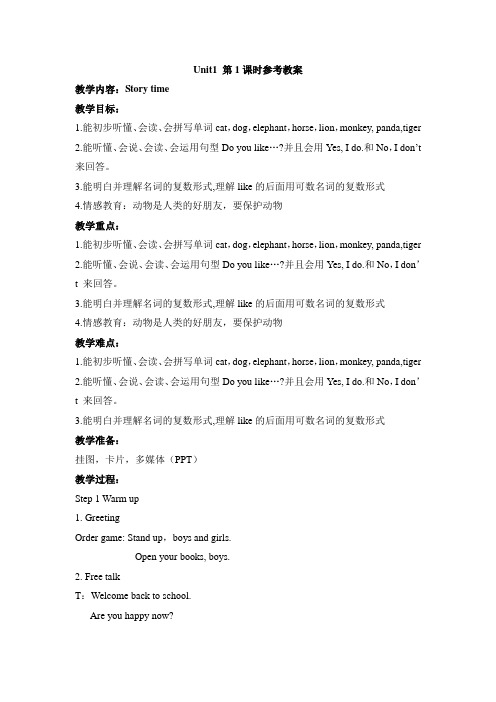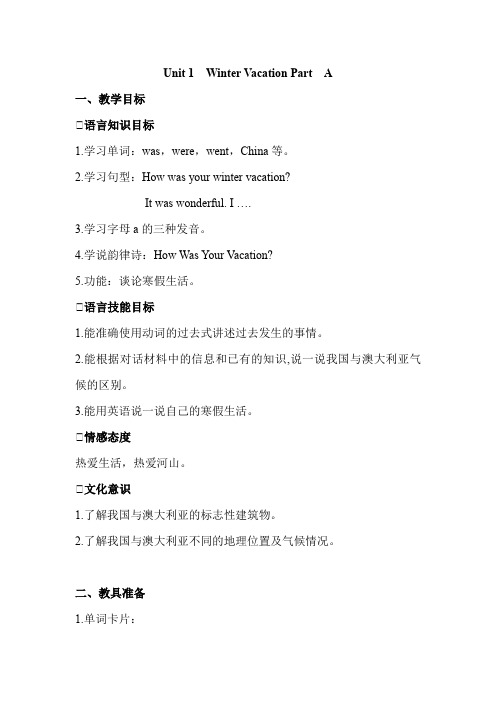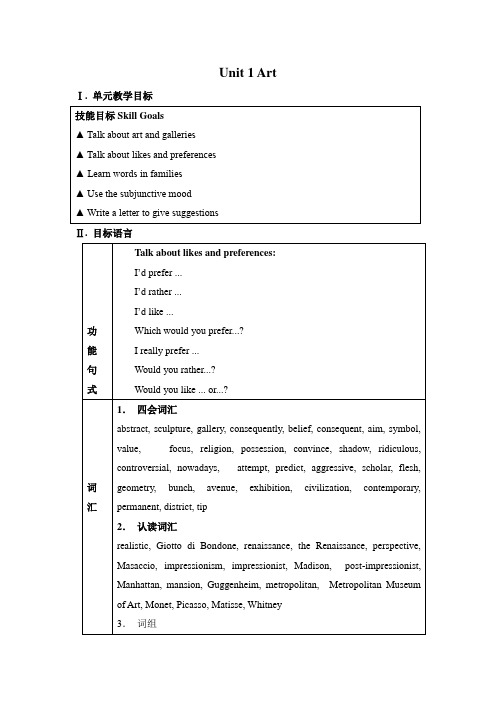unit1教案
- 格式:doc
- 大小:66.50 KB
- 文档页数:11

Unit1 第1课时参考教案教学内容:Story time教学目标:1.能初步听懂、会读、会拼写单词cat,dog,elephant,horse,lion,monkey, panda,tiger2.能听懂、会说、会读、会运用句型Do you like…?并且会用Yes, I do.和No,I don’t 来回答。
3.能明白并理解名词的复数形式,理解like的后面用可数名词的复数形式4.情感教育:动物是人类的好朋友,要保护动物教学重点:1.能初步听懂、会读、会拼写单词cat,dog,elephant,horse,lion,monkey, panda,tiger2.能听懂、会说、会读、会运用句型Do you like…?并且会用Yes, I do.和No,I don’t 来回答。
3.能明白并理解名词的复数形式,理解like的后面用可数名词的复数形式4.情感教育:动物是人类的好朋友,要保护动物教学难点:1.能初步听懂、会读、会拼写单词cat,dog,elephant,horse,lion,monkey, panda,tiger2.能听懂、会说、会读、会运用句型Do you like…?并且会用Yes, I do.和No,I don’t 来回答。
3.能明白并理解名词的复数形式,理解like的后面用可数名词的复数形式教学准备:挂图,卡片,多媒体(PPT)教学过程:Step 1 Warm up1. GreetingOrder game: Stand up,boys and girls.Open your books, boys.2. Free talkT:Welcome back to school.Are you happy now?S:Yes, I am.T:Let’s enjoy our English lessons now. Can you sing or say rhymes?通过这个环节让学生提前进入学习英语的氛围中。

英语(基础模块一上册)教案Unit1 Ready for Your Campus Life 课题:Ready for your campus life课时:4学时授课人:张燕凌教学目标1.谈论人名。
2.谈论来自何处。
3.介绍自己所在班级。
4.掌握“主—系—表”结构和“there be”句型。
5.掌握代词和介词的基本用法。
6.学会如何发前元音[i:]与[i]教学重、难点教学方法:讲解法、分析法、提问法、讨论法教学过程:(一)Warm-up1.老师首先用英语向全班学生作自我介绍,并提出新学习阶段的英语学习要求。
例如:Hello, everyone. My name is…. I’m your English teacher this year. Let’s do our best together to improve our Learning of English. Now at the beginning of this term, I would like to advise you to plan your time carefully. Be sure to have enough time to recite the new words and useful expression, to listen to enough English tapes, to read many English articles, to do oral practice as much as possible and to finish your homework on time.Second, I advise you to make good use of your time in class. Listening carefully in class really means less work later. Taking notes will help to remind you what the teacher said.Another important suggestion is that you should develop a good attitude towards your English reading, listening, speaking and writing. Don’t be afraid of making mistakes when you are speaking English. Just try your best to say what you want in English every time.I’ll do my best to help you and I hope everyone will get a greatprogress in the shortest possible time ….此外,还可以设计一些常用口令、手势、规定一些纪律,以便在以后的教学中,形成良好的习惯,达成默契。

Unit 1 Winter Vacation Part A一、教学目标◆语言知识目标1.学习单词:was,were,went,China等。
2.学习句型:How was your winter vacation?It was wonderful. I ….3.学习字母a的三种发音。
4.学说韵律诗:How Was Your Vacation?5.功能:谈论寒假生活。
◆语言技能目标1.能准确使用动词的过去式讲述过去发生的事情。
2.能根据对话材料中的信息和已有的知识,说一说我国与澳大利亚气候的区别。
3.能用英语说一说自己的寒假生活。
◆情感态度热爱生活,热爱河山。
◆文化意识1.了解我国与澳大利亚的标志性建筑物。
2.了解我国与澳大利亚不同的地理位置及气候情况。
二、教具准备1.单词卡片:(1)本课新单词的卡片。
(2)本课要学习的动词及其过去式的单词卡片。
2.Peter和Lily的图片。
3.一朵纸花或塑料花。
4.录音机或教学光盘。
三、教学过程Step 1 Warming up1.师生互致问候。
2.教师播放录音,全班学生齐唱歌曲:What Will You Do In Summer? Step 2 Review1.根据歌曲内容,教师说:“Summer vacation is in July and August.(教师在黑板右边写出July and August)What will you do in summer?”2.请学生自由回答,教师在黑板上July and August的下面写出一些学生说到的句子中的词组,如:go to Beijingvisit the Great Wallwatch TVgo swimmingdo my homework…3.采用不同的方式操练这些词组,巩固词组中动词的音义形。
4.呈现课题。
(1)教师说:“Summer vacation is in July and August.Today is ….(将今天的日期板书在July and August的前面)Winter vacation is in ….(将寒假的日期写在今天日期的前面)Today let’s talk about the winter vacation.”板书如下:(寒假的日期)(今天的日期)July and Augustgo to Beijingvisit the Great Wallwatch TVgo swimmingdo my homework(2)揭示课题并板书:Unit 1 Winter Vacation Part A。

Unit 1 In class一、单元教学目标(一)日常交际用语Open your books/the door. Close the window.Stand up. Sit down. Come in, please. I’m sorry.(二)词汇1.三会词汇: in class, stand up, Mr, sit down,please.sorry , come in, blackboard, rubber, don’t=do notlisten to, parrot2.四会词汇: open, the , door, close, window, book(三)语音:能听懂、会说、发音准确字母b在单词中的读音二、单元教学重点、难点重点:句型:Open/Close your books. Stand up. Sit down.词汇:三会与四会词汇。
语音:字母b在单词中的读音难点:句型的正确读法和在情境下的正确运用。
词汇:open, close 的用法字母b在单词中的读音三、单元教学课时第一课时:Story time第二课时:fun time, Cartoon time第三课时:sound time ,rhyme time and check time第一课时.Unit1 in class (story time)教学目标:1、知识、能力目标:1)能正确理解、掌握对话内容,并能朗读对话。
2)能正确地听、说、读单词 door, window ,blackboard , stand up, sit down,open,close.3)能在真实的情景中正确运用please…. Come in/和日常交际用语I’m sorry2、策略目标:能与别人相互合作,共同完成学习任务。
3、情感目标:培养学生学英语的兴趣,运用英语的意识。
教学重点:能正确理解掌握对话,并能朗读表演。
教学难点:1、能比较流畅地朗读对话,并能运用所学对话描述。

Unit 1 Art Ⅰ. 单元教学目标Ⅱ. 目标语言Ⅲ. 教材分析与教材重组1. 教材分析本单元以Art为主题, 主要介绍了西方绘画简史,描写了曼哈顿最好的艺术长廊。
帮助学生了解更多有关美术的背景知识,分析中西方艺术史上各大流派的特点,指出其代表性的画家和作品,并对中西方绘画艺术进行比较。
最后要求学生为当地举办的一场别开生面的画展提出合理化建议。
1.1 Warming Up部分要求学生运用相关的目标语言对自己所喜欢的艺术形式和艺术流派展开讨论,并说明喜欢的原因。
1.2 Pre-reading让学生讨论有关画展或书中的艺术作品以及西方不同历史时期的著名画家。
1.3 Reading介绍了西方绘画简史上不同历史时期的艺术流派、艺术特点及其代表性的画家和作品等。
1.4 Comprehending要求学生在理解课文的基础上,写出三件有关西方艺术史的事并指出西方艺术风格变化大的原因。
1.5 Learning about Language由Discovering useful words and expressions 和Discovering usefulstructures两部分组成。
要求学生对课文进行概括和总结,找出所提供单词的词根,并学习虚拟语气在条件状语从句中的运用。
1.6 Using Language是由Reading, Listening, Discussing 和Writing四部分组成,通过对学生听说读写综合能力的培养,要求学生在了解艺术长廊相关知识的基础上,为当地举办的一场别开生面的画展提出合理化建议。
1.7 SUMMING UP 要求学生总结本单元所学的知识。
1.8 LEARNING TIP在阅读技巧方面对学生进行指导。
2. 教材重组2.1 Warming Up, Pre-reading, Reading和Comprehending四部分都是关于西方绘画简史的内容,整合为一节精读课。
2.2 Learning about Language中的Discovering useful words and expressions 以及Workbook中的USING WORDS AND EXPRESSIONS 都是关于形容词、动词和名词后缀及其三者之间的相互转换,整合为一节语言学习课。

人教版英语九年级Unit-1-教案Unit 1 How can we become good learners?学习目标认知目标:1. Talk about how to study. 学会讨论各种学习方法和策略。
2. Find out your suitable learning methods. 找出适合自己的学习方法。
情感目标:通过对学习方法的学习,培养学生用正确而科学的方法做事的能力,明白“一份耕耘,一份收获”。
技能目标:(1)熟练掌握下列词汇:aloud pronunciation discover repeat note pronounce increase speed partner create active connect review knowledge wisely born attention(2)熟练掌握下列短语:work with friends ask the teacher for help read aloud look up practice pronunciationconnect…with…pay attention to(3)掌握下列句型:How do you study English?I learn by working with a group.Do you learn English by reading aloud?Yes, I do. It helps my pronunciation.How can I read faster?You can read faster by reading word groups.How can I improve my pronunciation?One way is by listening to tapes.But whether or not you can do this well depends on your learning habits.重点、难点(Key points and difficulties)1. 学会运用how来询问做事方式2. 学会运用by + doing的结构表达做事方式。
Unit1 Listening优秀教案1.语言知识目标了解盲文的创始人路易斯·布莱尔的个人经历和导盲犬的工作内容。
2.语言能力目标培养学生在听前对听力材料进行预测,并激活背景知识的能力;把握细节信息的能力。
3.情感态度与文化意识目标通过对盲文创始人路易斯·布莱尔个人经历和导盲犬工作情况的了解,使学生对于盲人的生活状况有更深切的了解,更能激发他们伸出手,帮助盲人和其他的残疾人。
重点难点1.教学重点:培养学生在第一遍听完后,掌握听力材料大意的能力。
2.教学难点:在听力材料开始前,如何激发学生的背景知识;在学生背景知识缺乏的情况下,如何进行听力指导。
课前准备1.学生的学习准备布置学生在课前上网查找关于盲文及创始人的情况,了解一些导盲犬工作的情况。
2.教师的教学准备查找相关信息,有条件的话,借一本盲文书给学生看看,让学生对盲人的生活有更加深入的了解。
3.教学用具录音机教学过程Pre-listeningBefore the students list en,ask them to discuss the following questions:1.Do you know what Braille is?2.What is it used for?3.How does it work?4.Do you know what the Chinese system of Braille looks like?(See Page 53 for some hints.)Suggested answers:Braille is a system by which blind people can read by feeling raised dots on a page. Both English and Chinese system of Braille use six dots. Their forms are similar,but their meanings are different. That's to say,Chinese blind people can't understand the English system of Braille.[设计说明]在听力训练正式开始前,在班级里组织讨论,激活学生的背景知识,有利于随后进行的关于盲文创始人路易斯·布莱尔的生平介绍的听力训练顺利展开。
北师大版高中英语选修必修一unit1教案北师大版高中英语选修必修一Unit1教案教学目标:1. 让学生掌握与旅行相关的基本词汇和表达方式。
2. 培养学生的跨文化交流意识,了解不同国家的文化和风俗。
3. 提高学生的英语听说读写能力,特别是口语交际能力。
教学内容:1. 与旅行相关的基本词汇,如:旅行社、导游、地图、航班等。
2. 旅行中的常见问题及应对措施。
3. 跨文化交流的基本知识。
教学难点与重点:重点:旅行词汇的掌握与运用,跨文化交流的意识。
难点:如何引导学生结合实际情况,灵活运用所学知识进行口语交流。
教具和多媒体资源:1. 投影仪与PPT课件2. 旅行照片、视频素材3. 旅行相关物品的实物模型,如:护照、行李箱等。
教学方法:1. 激活学生的前知:通过提问学生过去的旅行经历,激活他们对旅行的兴趣和记忆。
2. 教学策略:讲解、示范、小组讨论、角色扮演。
3. 学生活动:设计旅行计划、模拟导游讲解等。
教学过程:1. 导入:故事导入 - 讲述一段有趣的旅行故事,引起学生的兴趣。
2. 讲授新课:首先介绍旅行相关的基本词汇,再深入到跨文化交流的话题。
通过图片和视频展示不同国家的文化和风俗。
3. 巩固练习:小组活动,每组选择一个国家,模拟该国的旅行情景,运用所学词汇和表达进行角色扮演。
4. 归纳小结:总结本节课的重点内容,回顾旅行相关的词汇和跨文化交流的重要性。
评价与反馈:1. 设计评价策略:小组报告、观察、口头反馈。
2. 反馈:针对学生的角色扮演给予具体指导建议,鼓励他们下次做得更好。
作业布置:1. 收集5个与旅行相关的英文表达。
2. 写一篇关于自己最难忘的旅行经历的短文。
3. 与家人或朋友用英语进行一次模拟旅行计划交流。
教师自我反思:本节课的导入部分较为生动,成功引起了学生的兴趣。
但在讲解过程中,对于某些专业词汇的讲解还不够深入,下次应加强这方面的教学。
Unit 1 My school一、单元整体分析本单元是人教版英语四年级下册的第一单元,单元话题是“My school.”本单元重点学习学校、校舍;场馆的名称及相应的位置。
共三个版块:A 部分,B部分和C 部分。
A、B部分呈现新知识点,C部分是以讲故事形式巩固或延展知识面。
共分四课时来学习。
本单元A,B部分的Let’s learn 主要学习学校功能教室的名称。
Let’s talk. 以对话的方式引出重点句型。
read and write 部分呈现了本单元的四会单词及句型,从中学会了正确的书写格式。
Let’s spell 部分,要求学生通过听音、跟读,理解字母组合“er”的正确发音。
此外Look,ask and answer,Let’s do,Let’s play,Let’s sing,Let’s check和C部分的story time 则是通过多种多样的活动,与School 串联起来,让学生们在轻松愉快的情景中习得语言,运用语言。
本单元所需要掌握的询问功能室的位置的句型“Where’s the …It’s on the ….”在前面的教材中没有集中涉及,但是对于疑问代词“Where”同学们并不陌生。
询问某人来自哪里的句型“Where are you from”在三年级下册教材中已经学过。
这个句型的表达对本单元的教学有一定的帮助。
二、单元教学目标1. 知识目标(1)能听、说、读四会单词teachers’ office;library;playground;computer room;art room;music room ;first floor;second floor。
及四会句型“This is a library. That is the playground.”。
(2)能听懂、会说Part A、B 中Let’s talk与Let’s learn中的对话,并能在实际生活中得以运用。
(3)能够理解字母组合“er”在末尾时的发音规则。
深圳市宝安职业技术学校 英语 课 课 时 授 课 计 划 班级:11数控3班 课时:2 授课时间:2011年 9 月 5 日 教师:龙凌珠 课题 Unit 1 Nice People, Nice Places
目的要求: To understand the dialogue. To process the information in the listening and master the functional sentences related to the topic. To talk about people and places in simple English.
重点难点: The functional sentences. To talk about people and places in simple English.
教学方法及教具: Teaching and practicing Multimedia and Recorder
教学反思: Most of students have acquired this unit.
作业或思考题: 1. Ask the students to read the dialogue. 2. Exercises of Unit 1 in workbook 课时授课计划(副页) 课堂教学过程: Step One Warming up I. Give the students time to look at the picture at the first page of Unit 1. And discuss the following questions: 1. Have you ever visited the place? 2. What do you know about the place? 3. In which country is the building? II. Ask the students to listen to the words and match the pictures with the words shown in their textbook. III. Ask the students to answer the questions: 1. Do you know the places in the pictures? 2. Which country do you like to visit? 3. Do you know any other interesting places in the world? IV. Ask the students to listen to a dialogue and finish exercise 4 at page
Step Two Presentation of Listening I. Tell the students they are going to listen to a dialogue. Teach them how to use the words and expressions shown in the box in their textbook before listening. Give them some advices on listening skills, using the learning tips at page 13. II. Ask the students to listen twice and do the exercise 3 in their textbook. III. Ask the students to read the dialogue in pairs. IV. Ask the students to make a similar dialogue in pairs according to the example in exercise Step Three Listening Practice I. Help the students learn the new words and expressions by reading after the recorder. II. Ask the students to read a short passage, which has several missing words. III. Ask the students to listen to the passage and fill in the blanks using the given words in the box while listening. IV. Ask the students to listen again and finish exercise 6 at page 14. V. Ask the students to work in pairs and do exercise 7 at page 14.
Step Five Speaking Practice I. Ask the students to work in pairs and tell their partners something about their hometowns. II. Ask the students to work in pairs and finish exercise 2 at page 18.
Step Six Summary Key Vocabulary: long time no see, a lot of, tourist, all over the world… Key Sentences: Where are you from? There are many beautiful parks in the city. I’m from Australia. How do you find it? Long time no see. I’m just back from… There must be…
Step Seven Homework 1. Ask the students to read the dialogue. 2. Exercises of Unit 1 in workbook 深圳市宝安职业技术学校 英语 课 课 时 授 课 计 划 班级:11数控3班 课时:1 授课时间:2011年 9 月 8 日 教师:龙凌珠 课题:Unit 1 Nice People, Nice Places
目的要求: To understand the text about nice Canadians. To process information of nice Canadians in reading. To understand the grammar well: there be & adjectives.
重点难点: To master the language points. To describe places with there be & adjectives. To write several sentences to describe a picture using there be & adjectives.
教学方法及教具: Teaching and practicing Multimedia and Recorder
教学反思: Most of students have acquired this unit.
作业或思考题: Exercise book P11--13 课时授课计划(副页) 课堂教学过程: Step One Warming up I. Give the students some time to look at the picture at page 15. And discuss the following questions: 1. What do you know about Canadians? 2. Do Canadians talk to strangers at a party? 3. How does a foreigner feel in Canada? II. Let the students know that they will learn a passage about the nice Canadians. Step two Presentation of Reading I. Ask the students to read the words and expressions in the box of exercise 1 at page 15 before they begin to learn the text. II. Ask the students to listen and read the text. They could get help from the others or their teachers when they have some difficulties in reading. III. Ask the students to read the text again and finish exercise 3 at page 15. IV. Ask the students to read the text again and finish exercise 4 at page 16. Step Three Reading Practice I. Ask the students to finish exercise 5 at page 16. II. Ask the students to describe the pictures in pairs exercise 6 at page 16. III. Group work: exercise 7 at page 16 Encourage the students to do the exercise 1-3 at page 20.
Step Four Summary Step Five Homework Exercise book P11--13